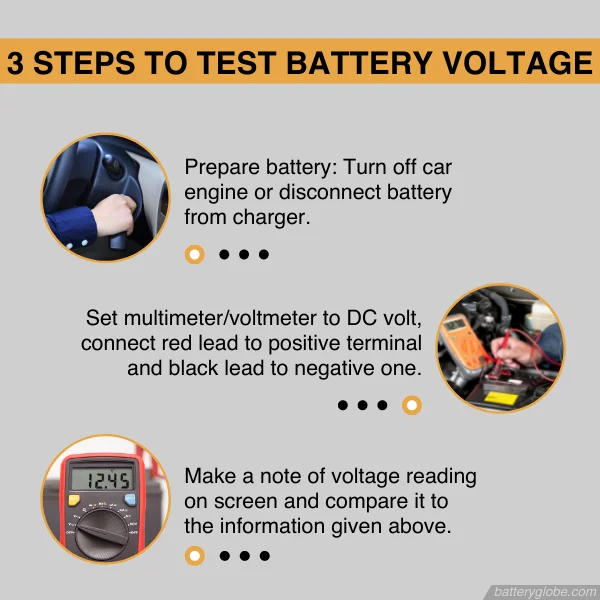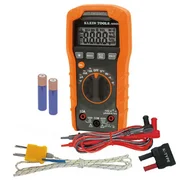Keeping your car battery in top condition is essential to help avoid a breakdown due to a dead battery. A simple check of the battery voltage will help you determine the battery’s current condition and whether you need to do any maintenance.
This article will show you how to test the voltage on lead-acid, Absorbed Glass Mat (AGM), and Lithium-Iron Phosphate (LiFePO4) batteries and explain what it means.
What Voltage Is A Car Battery?
Battery Voltage Meaning
Simply measuring the battery voltage, you can get an idea of the battery’s condition. By taking regular voltage measurements, you will be able to maintain your battery to prevent damage and spot when it may be about to fail.
Car Battery Voltage Chart
Your car’s electrical system uses 12 volts, so your car battery needs to supply between 12 and 13 volts for it to operate correctly. As the battery discharges, the voltage will drop. How much the voltage drops depends on the type of battery.

Lead-Acid Battery Voltage Chart
Lead-Acid Battery Voltage At Rest (Engine Off)
| State of charge | Lead-acid battery voltage |
|---|---|
| 100% | 12.70 |
| 90% | 12.50 |
| 80% | 12.42 |
| 70% | 12.32 |
| 60% | 12.20 |
| 50% | 12.06 |
| 40% | 11.90 |
| 30% | 11.75 |
| 20% | 11.58 |
| 10% | 11.31 |
| 0% | 10.50 |
12.6 volts or more: A voltage reading of over 12.6 volts indicates that your battery is fully charged and in good condition, so there is nothing to worry about.
12.5 volts: A reading of 12.5 volts shows that your battery is healthy and 90% charged. If your last trip was a short drive, the alternator might not have had enough time to recharge the battery. Recheck the voltage after a long drive.
12.3 – 12.4 volts: Your battery is about 75% charged or less and needs to be recharged at this level. It is recommended to use a battery charger and not rely on your car’s alternator.
12.1 – 12.2 volts: The charge level is about 50%, and you should connect a battery charger immediately.
12 volts or below: At 12 volts or below, you could damage your battery and shorten its working life. Connect a charger immediately, preferably a reconditioning charger that can reverse any damaging effects of being undercharged.
Find purchasing options for a smart charger online:
NOCO GENIUS 5

NOCO GENIUS 10

Lead-Acid Battery Voltage When The Car Is Starting
Starting your engine is the primary purpose of your battery and is the most significant drain. Because a large current is flowing during starting, you can expect the voltage to drop to around nine or ten volts.
It should quickly return to normal voltages once the engine has started.
Lead-Acid Battery Voltage When The Car Is Running
While your car engine is running, the alternator constantly charges the battery, controlled by the regulator, to avoid overcharging. The voltage at the battery terminals should be between 13.7 and 14.7 volts.
Absorbed Glass Mat Battery Voltage Chart
AGM batteries are lead-acid batteries but have improved power characteristics over the standard flooded acid battery type.
The voltage readings are similar to lead-acid, although they may be around 0.2 volts higher at some charge levels.
| State of charge | AGM battery voltage |
|---|---|
| 100% | 12.80+ |
| 90% | 12.70 |
| 80% | 12.50 |
| 70% | 12.35 |
| 60% | 12.15 |
| 50% | 12.05 |
| 40% | 11.95 |
| 30% | 11.81 |
| 20% | 11.66 |
| 10% | 11.51 |
| 0% | 10.50 |
Lithium-Iron Phosphate Battery Voltage Chart
LiFePO4 batteries use very different technology to flooded lead-acid batteries, and the voltage levels are significantly higher across the range of charge.
When a LiFePO4 battery is fully charged, it will initially have a voltage of around 14.4 volts, but this will drop slightly once the charger is removed. If the battery voltage remains at 13.6 volts or higher, it is fully charged.
| State of charge | Lithium battery voltage |
|---|---|
| 100% | 14.4 |
| 90% | 13.4 |
| 80% | 13.3 |
| 70% | 13.2 |
| 60% | 13.1 |
| 50% | 13.05 |
| 40% | 13 |
| 30% | 12.9 |
| 20% | 12.8 |
| 10% | 12 |
| 0% | 10 |
At What Voltage Should A Car Battery Be Replaced?
Before checking the voltage, make sure the battery is fully charged, preferably using a battery reconditioning charger. Once fully charged, check the voltage. Initially, it may seem okay, but there is a problem if the voltage drops rapidly.
If the voltage falls below 12 volts, it is usually a sign of a damaged battery, and if it drops to 10.5 volts or lower, you need a new battery.
How To Test Car Battery Voltage?
Using a voltmeter or multimeter is a simple task to check a battery’s condition.

Step 1: Prepare The Battery
Ensure your engine is off or the battery is disconnected from the charger for at least ten minutes before taking the measurement.
Step 2: Set Your Multimeter/Voltmeter To DC Volts
Set the multimeter/voltmeter to the DC volt range to read up to 20 volts or more. Connect the red (positive) lead to the positive battery terminal and the black (negative) lead to the negative terminal.
Step 3: Take The Voltage Measurement
Make a note of the voltage reading and compare it to the information given above.
See Multimeter for sale here:
Klein Tools MM400

Etekcity MSR-A2000

Any Alternative Testing Method?
An alternative method is to take the battery to a mechanic who can check the battery with a load tester for a more accurate test.
Conclusion
We rely on our car battery to start our car day in and day out. However, batteries have a finite life, and they will eventually fail.
You can get the most out of your battery by checking the voltage regularly and keeping it in top condition. This is a simple task for any home mechanic and will save you money in the long run.
FAQs
What Should A 12-Volt Battery Read When Fully Charged?
A 12-volt battery should have the following voltage measurement in a fully charged condition. These voltages are typical after leaving a battery to “rest” for a few hours after charging before taking the measurement.
- Lead-Acid/AGM – around 12.6 to 12.8 volts
- LiFePO4 – around 14 volts
What Car Battery Voltage Is Too Low?
The primary use of a car battery is to start the engine, and for this, it needs a lot of power. For this reason, you should keep your car battery at or close to 100% charge. If your lead-acid battery is left in a partial charge state, below 12.5 volts, there is the potential for damage.
LiFePO4 batteries have different internal chemistry, but you should not let them go below 12 volts.
When To Replace Your Car Battery Voltage?
The voltage level at which you should replace your car battery depends on the type of battery. If you fully charge a lead-acid battery, but the voltage measurement is still 12 volts or fewer, then it is at the end of its life.
For LiFePO4 batteries, you should have a voltage of around 14 volts after charging.
